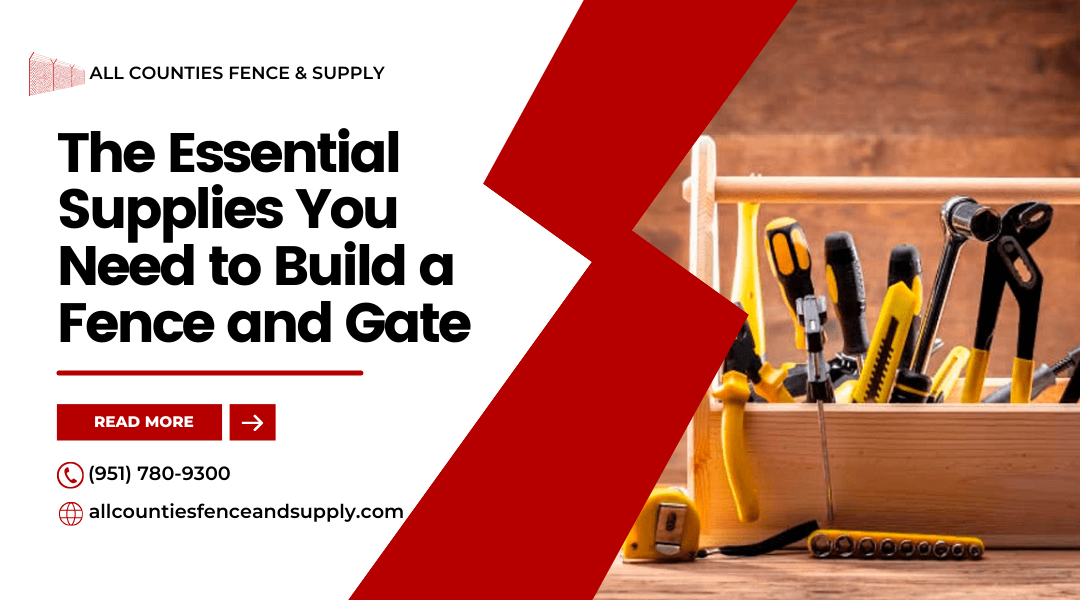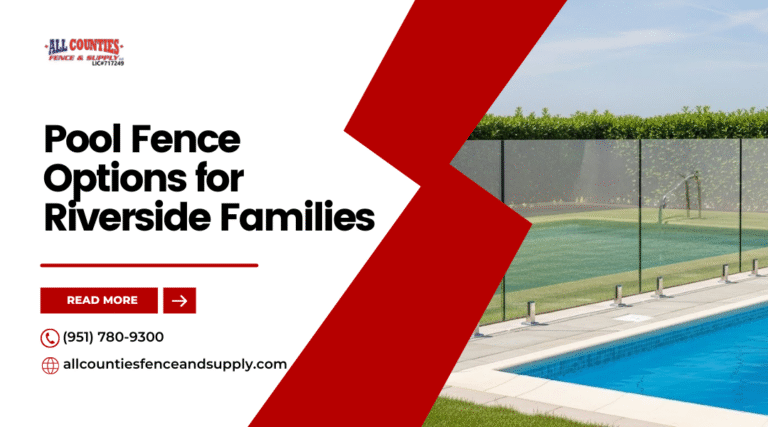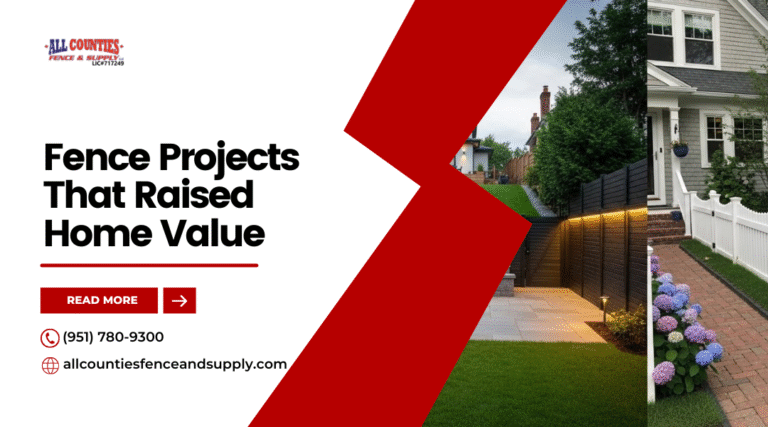When starting a DIY fencing project, knowing what supplies you need is essential for a successful installation. With the right materials and tools from All Counties Fence & Supply, you can ensure a sturdy and attractive fence that enhances your property. Having the necessary supplies will make your project smoother and more efficient, helping you avoid common pitfalls.
You’ll want to consider various types of fencing materials, such as wood, vinyl, iron, or chain-link, based on your needs and preferences. Each type offers unique benefits, whether it’s aesthetic appeal, durability, or cost-effectiveness. All Counties Fence & Supply provides a range of options to fit your style and budget, ensuring you have everything you need for your project.
Additionally, don’t overlook essential tools and accessories, like posts, rails, and gates, which are vital for proper installation. With expert advice and high-quality supplies from All Counties Fence & Supply, you’re on your way to creating a beautiful and functional fence that serves your needs for years to come.
Choosing The Right Fence Materials
Selecting the right fence materials is crucial for the success of your DIY project. You’ll want to consider various types of materials based on your needs, budget, and style preferences. The right choice will help ensure durability and beauty.
Wood, Vinyl, Metal, And Composite Options
Wood Fences: These are popular for their classic look. You can choose options like pine or cedar. Wood fences can be custom built for various styles, including privacy and picket fences.
Vinyl Fences: This low-maintenance option resists rotting and fading. Vinyl comes in several colors and styles, making it versatile. It tends to be more expensive than wood but offers great durability.
Metal Fences: Common options include chain-link and wrought iron. Metal offers security and strength. Chain-link fences are cost-effective and great for enclosing a yard but provide little privacy.
Composite Fences: Made from recycled materials, these are eco-friendly. They mimic the look of wood but last longer and require less upkeep. Composite options are available in various colors and styles.
Factors To Consider When Selecting Materials
When choosing your fence materials, think about the following:
- Durability: How long do you want your fence to last? Wood may rot; metal can rust.
- Cost: Set a budget. Wood is often cheaper upfront but requires maintenance. Vinyl and metal might have higher starting prices but can save on upkeep.
- Style: What look fits your home? Consider the architectural style of your house and the surrounding area.
- Purpose: Determine why you’re installing the fence. Is it for privacy, security, or decoration? Some materials are better suited for specific purposes.
Best Fence Types For Different Purposes (Privacy, Security, Decorative)
Privacy Fences: Typically tall and solid, wood and vinyl are great choices. They block views and noise and can add value to your property.
Security Fences: Metal options like chain-link or wrought iron offer high security. You can also enhance wood fences with locks and security features.
Decorative Fences: Picket fences are charming for gardens or front yards. Materials like vinyl or wood are popular for their aesthetic appeal. Choose colors and designs that complement your home’s style.
Essential Tools And Equipment For Fence Installation
When installing a fence, having the right tools and equipment is key. The success of your project depends on accurate measurements, proper digging, and secure fastening. Each tool serves a specific purpose that plays a vital role in the installation process.
Measuring And Layout Tools (Tape Measure, Marking Paint, String Line)
Measuring tools are essential for precise installation. A measuring tape allows you to determine the correct distances between fence posts. This ensures that your fence is straight and evenly spaced.
Using marking paint helps you visualize the layout. By marking the ground where each post will go, you can avoid errors before you start digging.
Lastly, a string line is useful for maintaining alignment. By stretching a string between posts, you can check that everything is straight as you go. This combination of tools helps create a professional-looking fence.
Digging And Post-Setting Tools (Post Hole Digger, Auger, Shovel)
For digging post holes, a post hole digger is essential. This tool helps you create deep holes for your posts, ensuring stability. It typically features two handles, allowing you to scoop out dirt effectively.
An auger is another option. It is a drill-like tool that makes it easier to dig deeper holes without much effort. For larger projects, consider a powered auger, which can speed up the process significantly.
A shovel is useful for clearing debris and moving dirt when setting posts. Be sure to have these tools ready for an efficient digging process.
Cutting And Fastening Tools (Saw, Drill, Hammer, Nail Gun, Screws)
When it comes to cutting materials to size, a saw is necessary. Depending on your fence material, you might need a hand saw or a power saw for quicker, cleaner cuts.
A drill is important for making holes in your posts and rails for screws. It makes fastening parts together easier and more secure.
A hammer is a traditional tool you may use if you choose nails instead of screws. For faster work, a nail gun can make the job quicker and provide a strong hold.
Don’t forget the screws or nails that you need to secure your fence. Choosing the right ones for your material matters for durability. Proper installation requires the right tools tailored to your needs.
Key Structural Components Of A Fence
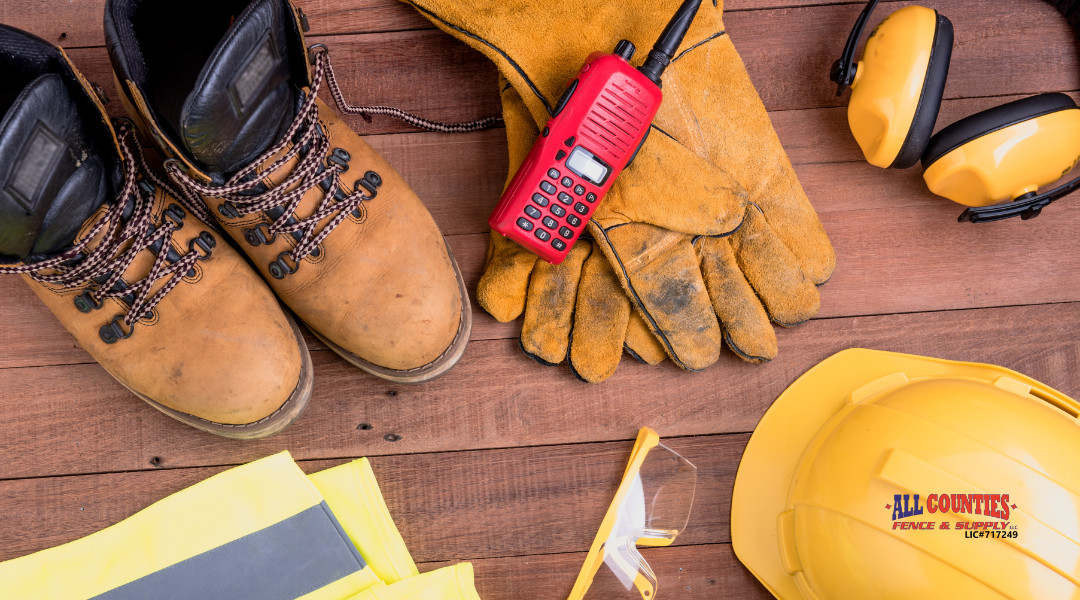
When building your fence, it’s essential to focus on three key components: fence posts, rails and panels, and gates and hinges. Each plays a vital role in ensuring your fence is strong, functional, and long-lasting.
Fence Posts – Materials, Sizes, And Installation Tips
Fence posts are the backbone of your fence. They support the entire structure and should be selected carefully. Common materials include wood, metal, and vinyl.
- Wood: A popular choice that blends well with nature. Use pressure-treated lumber for durability.
- Metal: Offers strength and longevity, especially galvanized steel, which resists rust.
- Vinyl: Low maintenance and comes in various colors but can be more expensive.
Choosing the right size is crucial. Posts typically range from 4 to 6 inches in width. Ensure they are buried at least one-third of their height in the ground for stability. When installing, use concrete to secure them and allow sufficient time to cure.
Rails And Panels – Connecting Your Fence Securely
Rails and panels provide the structure and fill of your fence. Rails connect the posts and support the panels, which form the face of the fence. You have several options for materials and styles.
- Wood Rails: Classic and versatile, but they need regular maintenance.
- Metal Rails: Offer stronger support and are often used in commercial settings.
Panels come pre-made or can be built on-site. Pre-made panels save time but ensure they fit your style. Use screws for attaching panels to the rails as they create a stronger connection than nails.
Gates And Hinges – Ensuring Smooth Operation
Gates are the access points of your fence, and proper installation is critical. The gate should match the style of your fence and be made from the same materials. Ensure it is at least as sturdy as the rest of the fence.
Hinges play a significant role in the smooth operation of your gate. Heavy-duty metal hinges are best for larger gates. They should be spaced evenly, typically three hinges on a standard gate.
Ensure the gate swings freely and closes securely. Adding a latch will help keep it closed and enhance security. Regularly check and lubricate the hinges for the best performance.
Fasteners, Anchors, And Support Accessories
Fasteners, anchors, and support accessories are crucial for ensuring that your fence is stable and secure. Selecting the right materials for assembly provides strength and longevity to your project. Here are the essential components you need to consider.
Nails, Screws, And Brackets For Secure Assembly
When building a fence, the right fasteners make all the difference. Nails and screws should be corrosion-resistant, especially for outdoor use. Consider using galvanized or stainless steel options to withstand the elements.
Use wood or metal brackets for added support. These can help secure the corners and joints of your fence. Make sure to choose the correct size and type for your specific material, whether it’s wood, vinyl, or metal.
Ultimately, the choice of fasteners impacts the overall strength of your fence. Regularly check them to ensure they remain tight and secure over time.
Concrete And Gravel For Post Stability
Post stability is crucial for a durable fence. Concrete is often preferred for setting posts because it provides solid support. Mix it according to package instructions and make sure it’s well-compacted around the post.
Alternatively, gravel can be used for a more cost-effective solution. It allows for better drainage, helping to prevent rot in wooden posts. If you choose gravel, ensure it is compacted firmly and the posts are straight.
Choosing the right method for stabilizing your posts affects the lifespan of your fence. Evaluate your soil type and climate when making this decision.
Weatherproofing Materials (Sealants, Paint, And Stains)
Weatherproofing your fence is essential for protecting it from the elements. Use sealants on wooden fences to prevent moisture penetration. Look for products that are designed specifically for outdoor use.
Paint can add not only protection but also aesthetic appeal. Choose exterior-grade paint that can withstand UV rays and precipitation. Regular maintenance will help keep your fence looking great.
If you prefer a natural look, consider stains. They provide UV protection while allowing the wood grain to show. Regular application ensures long-lasting beauty and durability for your DIY fencing project.
Safety Gear And Protective Equipment
When working on a DIY fencing project, safety must be a top priority. The right safety gear and protective equipment can keep you safe from injuries and hazards that arise during construction. Here are essential items to consider.
Gloves, Goggles, And Dust Masks For Protection
Protective gloves are crucial when handling fencing materials. They prevent cuts and abrasions from sharp edges. Choose sturdy gloves designed for construction work.
Safety goggles protect your eyes from dust and debris. They are especially important when cutting or drilling materials. Look for goggles that fit well and offer fog-resistant options.
Dust masks are essential when working with materials that produce dust. They help keep you safe from inhaling harmful particles. Choose a mask that fits snugly to your face for maximum protection.
Proper Footwear And Clothing For Construction Work
Wearing the right footwear is key for protection and comfort. Choose steel-toed boots to protect your feet from heavy items. Non-slip soles can enhance grip on various surfaces.
Clothing should be appropriate for the work environment. Wear long sleeves and pants to shield your skin from sharp tools and materials. Avoid loose clothing that can catch on equipment.
Consider wearing a high-visibility vest if you’re working in or near traffic. This ensures that you are easily seen by others, reducing the risk of accidents.
Ladder And Safety Harness For Elevated Work
If your project requires working at height, use a sturdy ladder rated for the weight you will be carrying. Inspect the ladder before use to check for defects.
A safety harness is important for added protection. If you are working on a tall fence, a harness can prevent falls. Ensure that your harness is properly fitted and attached to a secure anchor point.
Always maintain three points of contact when climbing a ladder. This enhances your stability and reduces the risk of falling while working.
Tips For A Successful DIY Fence Installation
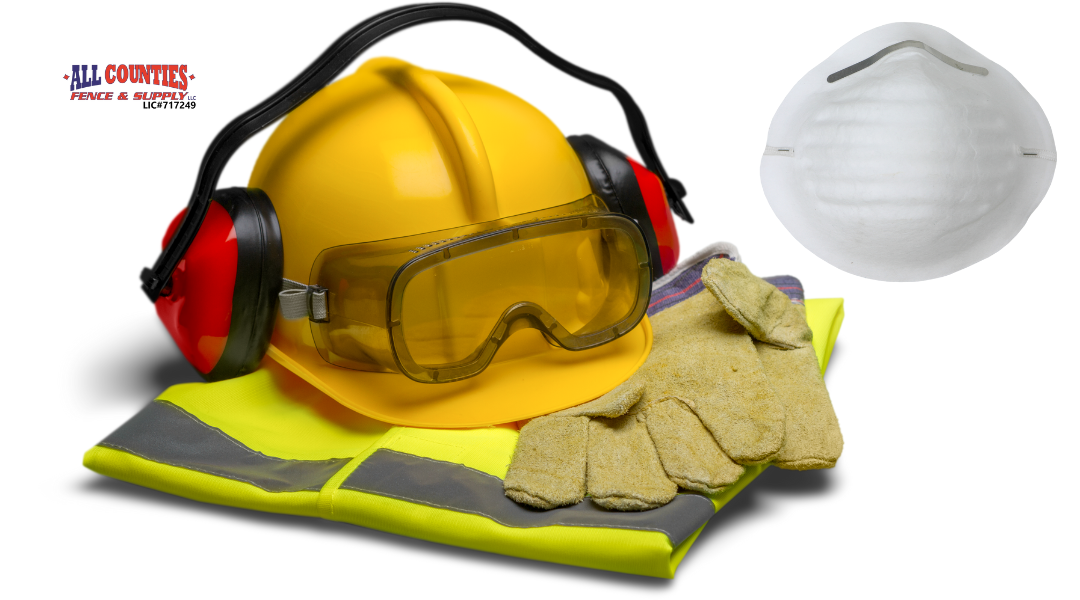
Installing a fence can be a rewarding project when you have the right approach. Planning ahead and avoiding common errors will help ensure your fence stands strong for years to come.
Planning And Measuring For A Straight Fence Line
Begin by determining the exact location of your fence line. Use stakes and string to mark where the fence will go. This will help visualize the layout, ensuring everything is straight.
Measure the total length of the fence, and take note of where gates will be. Always consider local regulations regarding property lines. Check with your local municipality to confirm boundaries and permits.
A tape measure and a level are essential tools for this stage. Double-check your measurements before moving on to avoid costly mistakes later.
Properly Setting Posts For Long-Term Stability
Setting your fence posts correctly is critical for its durability. Start by digging holes that are at least one-third the height of the post. This depth helps anchor the posts firmly in the ground.
Use concrete mixes to secure the posts, as it provides better stability compared to just dirt. Allow the concrete to cure for the recommended time. This typically takes at least 24 to 48 hours.
Consider using a post level to ensure your posts are vertical. Adjust if needed before the concrete fully sets to avoid a crooked fence.
Common Mistakes To Avoid During Installation
It’s easy to make small mistakes that can lead to bigger problems. One common error is not spacing the posts correctly. Ensure your posts are evenly spaced to maintain a consistent look and foundation.
Another mistake is rushing through the installation. Take your time to set posts properly and level the panels. Skipping these steps can lead to areas of weakness in the fence.
Lastly, don’t forget to check the weather. Rain or extreme temperatures can affect the curing of your concrete, leading to a less durable fence. Plan your installation on a suitable day for best results.
Where To Buy Quality Fencing Supplies
When starting your fencing project, knowing where to find quality supplies is crucial. You have choices between local stores and online options, as well as specific suppliers known for reliability and value.
Comparing Local Vs. Online Fencing Supply Stores
Local fencing supply stores offer the advantage of immediate access. You can see products in person, allowing you to inspect materials and ask questions directly. This can be especially helpful when selecting items such as gates, panels, and posts.
On the other hand, online stores provide a broader range of products and often better prices. You can browse various brands and compare options without feeling rushed. Just remember to check shipping costs as they can sometimes offset any savings.
Both options have their merits. Choosing depends on your specific needs for convenience, availability, and cost.
Choosing Durable And Cost-Effective Materials
When selecting fencing materials, focus on durability and cost-effectiveness. Common choices include wood, vinyl, and aluminum.
- Wood: Offers traditional aesthetics but requires maintenance. Pressure-treated options resist rot.
- Vinyl: Low maintenance and resistant to weather. It has a higher upfront cost but lasts longer.
- Aluminum: Lightweight and rust-resistant. It often serves as a long-term investment.
Analyze the total cost, including long-term maintenance and lifespan. This diligence ensures you get the best value for your investment.
Why Buy From All Counties Fence & Supply?
Purchasing from All Counties Fence & Supply guarantees access to quality products tailored for your needs. They offer a variety of fencing materials suitable for various projects.
Their knowledgeable staff can guide you toward making informed decisions. They understand local regulations and can provide advice specific to Riverside, California.
Additionally, their prices are competitive. You often find unique items not available in larger chains. This combination of expertise and selection makes them a reliable choice for your fencing supplies.
Conclusion
Gathering the right fencing supplies is crucial for your DIY project. Knowing what you need will save time and ensure your fence is durable and strong.
Here are key supplies to consider:
- Fence Panels: Choose the type based on your style and budget.
- Posts: Strong posts are essential for stability.
- Post Caps: They add an attractive finish and protect the tops of posts.
- Concrete: Use this for securing posts in the ground.
- Tools: Basic tools include a level, measuring tape, and a post hole digger.
Always remember to assess your property and local regulations before starting. This will help you avoid any issues down the line.
For quality materials and expert advice, check out All Counties Fence & Supply. They have been serving Riverside and San Bernardino Counties since 1978.
Taking the time to plan and choose the right supplies will result in a successful fencing project that meets your needs.

